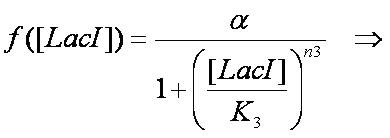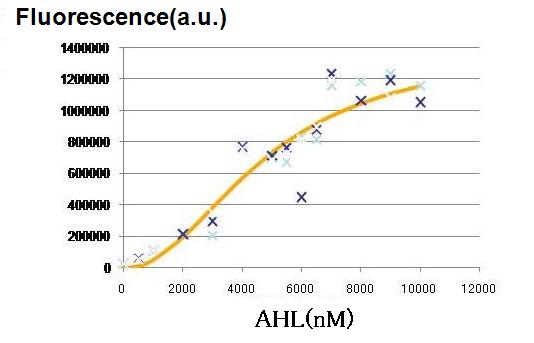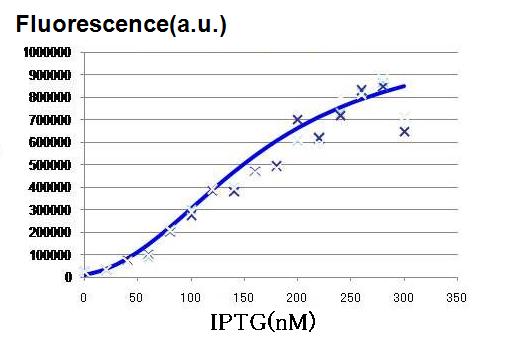Tokyo/Works/Assay
From 2007.igem.org
| Line 38: | Line 38: | ||
[[Image:hill IPTG.JPG|thumb|210px|'''Fig.2 The result of IPTG assay''' Fluorescence intensity as a function of the concentration of IPTG was determined. ]] | [[Image:hill IPTG.JPG|thumb|210px|'''Fig.2 The result of IPTG assay''' Fluorescence intensity as a function of the concentration of IPTG was determined. ]] | ||
'''Purpose''' | '''Purpose''' | ||
| - | + | By testing how LacI represses lux-lac hybrid promoter, parameters(n3,K3) should be decided. In order to adjust effective concentration of LacI, IPTG was added. | |
| - | + | <br><br> | |
| - | + | ||
| - | <br> | + | |
| - | + | ||
'''Result & Conclusion''' | '''Result & Conclusion''' | ||
| - | + | GFP fluorescence intensity was enhanced in IPTG-dose dependent manner. It indicates that the LacI repression was getting weak by adding IPTG. Taken together with the graph shown in Fig. 2 and the formulation of Hill function fitting described above, the characteristics of the hybrid promoter expressed in Hill function was determined. | |
| - | + | ||
| - | + | ||
====⇒see more [[Tokyo/IPTG assay|details]]==== | ====⇒see more [[Tokyo/IPTG assay|details]]==== | ||
<br> | <br> | ||
Revision as of 18:34, 26 October 2007
Works top 0.Hybrid promoter 1.Formulation 2.Assay1 3.Simulation 4.Assay2 5.Future works
Purpose of this assay Effect of AHL Effect of IPTG Preliminary assays
Purpose of this assay (Hill function fitting)
We have obtained data for our newly devised hybrid promoter. By Hill function fitting, we have determined n2, n3, K2, and K3.
⇒see more details
Effect of AHL
Purpose Bytesting how AHL activates lux-lac hybrid promoter, parameters(n2,K2) should be determined.
Result & Conclusion
GFP fluorescence increased in AHL-dose dependent manner, indicating that the hybrid promoter is enhanced by LuxR via AHL. Taken together with the graph shown in fig.1and formulation of Hill function fitting described above , the characteristics of the hybrid promoter expressed in Hill function, such as (n2,K2), is determined.
⇒see more details
2.IPTG assay
Purpose
By testing how LacI represses lux-lac hybrid promoter, parameters(n3,K3) should be decided. In order to adjust effective concentration of LacI, IPTG was added.
Result & Conclusion
GFP fluorescence intensity was enhanced in IPTG-dose dependent manner. It indicates that the LacI repression was getting weak by adding IPTG. Taken together with the graph shown in Fig. 2 and the formulation of Hill function fitting described above, the characteristics of the hybrid promoter expressed in Hill function was determined.
⇒see more details
Appendix: Preliminary assays
We conducted preliminary assays as practice experiments and check of materials and methods.
⇒See more details
Before(Formulation) << Assay1 >> Assay1 contents >>>> Simulation




